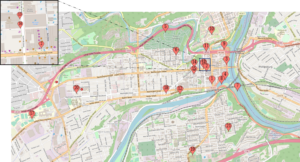Now that we have an understanding of the three types of resiliency, it’s time to start understanding how to build climate resiliency in our own communities. Our ultimate goal is to make our community stronger and better able to mitigate and adapt to climate change and weather hazards. That is an important but vague goal. How are we going to get there? What should we do first?
To get started, we should probably define “community”. What does that mean to you? Is it your block, neighborhood, your whole city? Maybe it is not geographically bounded but rather based on a school, faith-based organization, or group of people with similar interests to you. For this blog post and the examples below, I am going to define my community as Easton. Once you have defined your community, we can move to the next step.
Within our community, we want to identify the assets that already exist. Assets are the people, organizations, policies, physical spaces, and other resources within a community that help make it a better place to live, work, and play. It is important to understand your community’s assets so that you can leverage them to help achieve your resilience goals. Below are a few guiding questions to help you explore your community and find the good. These questions align with the Climate Resilience in Your Community Activity Book that we co-authored with the NOAA Office of Education.
- Where are decisions made in your community (e.g., City Hall, community building, Tribal office)? Is this a welcoming space that people can easily access?
- Where in the community do people like to gather?
- Are there green spaces in your community for people to enjoy?
- Does your community intersect with any bodies of water (e.g., stream, river, lake, ocean)? Is there vegetation on the edges of those water bodies, or does human development go all the way to the edge of the water?
- Are there paths or sidewalks for people to walk or bike around your community safely?
- Does your community have a public transportation system (e.g., buses, trains, subway)?
- Does your community have a climate or resilience planning document? These are usually found on a community’s official website.
- Does your community have a public works department?
- Where can the community go when there is an emergency (e.g., fire department, police department, etc.)?
- What places of learning are in your community? This includes schools, colleges, libraries, science centers, museums, and any other place of learning.
- What organizations are working to make your community better? Some examples might include faith-based organizations, non-profit organizations, and community groups.
That was a lot of questions! To make it more concrete, below are some example answers from my community. The map that follows shows the locations of these community assets. Most decisions in Easton are made in City Hall (1) which is conveniently located in the downtown area on South 3rd Street. Residents enjoy gathering in the downtown area especially the Easton Public Market (2) and at Riverside (3) and Scott Parks (4). These parks plus other green spaces like the Karl Stirner Arts Trail (5) and Historic Easton Cemetery (6) are great resources to the community. Easton meets at three main bodies of water, the Delaware River (7), Lehigh River (8), and Bushkill Creek (9). There are certain areas where development goes close to the water’s edge, especially near downtown, but in many locations, parks and trails are adjacent to the water. These natural spaces help hold water during flooding events and clean urban runoff before it goes into the waterways. There are many sidewalks around the downtown area and up to Lafayette College (10) to improve walkability. The LANTA bus system services Easton as well as many other parts of the Lehigh Valley which makes it easier to get around without a personal vehicle. Easton has a Climate Action Plan, a Vulnerability Assessment, and is part of the Lehigh Valley Hazard Mitigation Plan. Easton has a large Public Works Department (11) that manages garbage and recycling, parks and recreation, urban forestry, and other city services. The Easton Fire Department (12) and Easton Police Department (13) are available to assist with emergencies throughout the city. There are many places of learning in Easton, including Lafayette College, the Easton Area Public Library (14), the Nurture Nature Center (15), Easton Arts Academy (16), and Easton Area High School (17). So many individuals and groups are working to make Easton better everyday. Some examples include the Easton Area Community Center (18), The Neighborhood Center (19), St. Luke’s Hospital (20), and the Boys and Girls Club of Easton (21).
Map of Easton with locations numbered to coordinate with the places in the paragraph above.
If you could identify places and organizations in your community to fit into the above categories, then congratulations! Your community already has some assets that will make it easier to achieve your resiliency goals. As we move towards taking action to increase community resilience, continue to add to this assets list. The more you look around, the more good you are likely to see.


